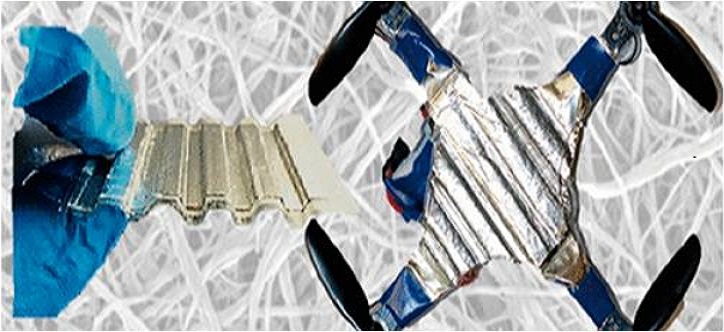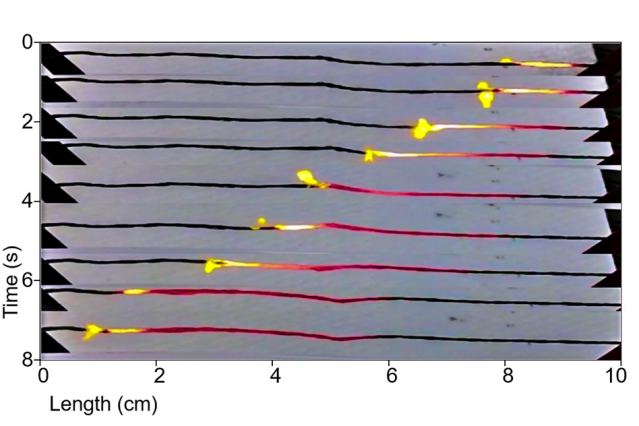Multitudes of researchers have exercised their mental muscles trying to make man-made products mimic naturally-occurring structures. According to University of Michigan researchers, the cartilage in your knees might provide the inspiration for a “structural battery” prototype that would be durable and easy to shape. This blog has long promoted the idea of structural batteries, energy storage systems that could double as strengthening elements in the aircraft shell. Storing energy in car bumpers or airplane wings has some risk elements. What will happen to a battery cracked by collisions on the ground or excessive loads in the air, for instance. Nicking or puncturing existing batteries can cause flaming catastrophes. As U of M researchers note, “[Structural batteries] been a long-term goal for researchers and industry because they could reduce weight and extend range. But structural batteries have so far been heavy, short-lived or unsafe. The school’s tests, described in ACS Nano, ended up with damage resistant, rechargeable zinc batteries with a …
Your Battery is on Fire – and That’s a Good Thing
Mary Grady’s report at AvWeb alerted your editor to this exciting development. Imagine a battery capable of seven times the energy output of any lithium battery now in existence, made of non-toxic, easily recycled materials. One aspect of this new energy source might give you pause, however. You have to set fire to the battery to extract all that energy. With recalls of so-called “hoverboards” and still warm memories of Tesla and 787 Dreamliner battery fires, folks might be excused for wanting to avoid anything that combines fires with batteries. The new approach, from MIT researchers, uses carbon nanotubes as its base, and these don’t self-ignite like their lithium cousins. Michael Strano, the Carbon P. Dubbs* Professor in Chemical Engineering at MIT found that coating a carbon nanotube with combustible material and lighting one end would produce a current as the fire progressed along the tube. Even though the amount of energy generated was low, Dr. Strano and his students …
Beating Plants at Their Own Game
Going to medical school to learn how to use bacteria to make gasoline may seem like a complicated process, but the developers of a new way of extracting biofuels from sunlight say it’s not. You may remember Dr. Daniel Nocera’s efforts a few years ago to create a bionic leaf, a simple way to extract oxygen and hydrogen from water when the leaf in water was exposed to sunlight. Several other such “water splitters” have achieved newsworthiness in the last few years, but each has the impediment of not delivering hydrogen in a readily useable way. Usually, any H2 produced has to be compressed, stored in hydrides, or encapsulated in some way to make it a viable fuel. There is not a national infrastructure to allow hydrogen to be distributed as readily as gasoline or Diesel. Researchers working with Dr. Nocera “at Harvard University’s Faculty of Arts and Sciences, Harvard Medical School and the Wyss Institute for Biologically Inspired Engineering …
Unzipped Nanotubes Show Energetic Promise
Rice University, supported by the Air Force Office of Scientific Research (AFOSR), has demonstrated “a way to boost the efficiency of the ubiquitous lithium ion (LI) battery by employing ribbons of graphene that start as carbon nanotubes.” The AFOSR explains, “Four years ago, [Rice chemist James] Tour’s research team demonstrated that they could chemically unzip cylindrical shaped carbon nanotubes into soluble graphene nanoribbons (GNR) without compromising the electronic properties of the graphitic structure. A recent paper by the Tour team, published in IEEE Spectrum and partially funded by AFOSR, showed that GNR can significantly increase the storage capacity of lithium ion (Li-ion) by combining graphene nanoribbons with tin oxide. “By producing GNR in bulk, a necessary requirement for making this a viable process, the Tour team mixes GNR and 10 nanometer wide particles of tin oxide to create a slurry. GNRs, a single atom thick and thousands of times longer than they are wide, not only separate and support the …


